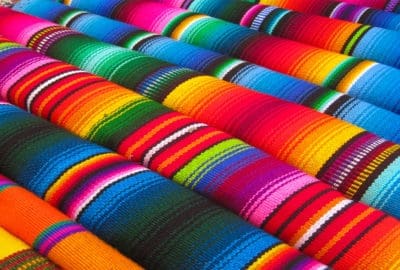GUATEMALAN TEXTILES
THE PROCESS
Guatemala is known for its rich, vibrant and colourful textiles. The traditional textiles are handmade with a lot of work going into each step of the intensive process.
Cotton carding and cleaning
It all starts with raw cotton, which the women beat down with sticks to soften the fibers. After the cotton can be separated easily, they take small handfuls and pull it apart. This process cleans the materials and removes any debris that may have been hiding in it. After it’s been carded and cleaned, the artisan pulls a thin piece from the bundle and spins it to create a thread.

Dyeing
One of the most dramatic aspects of preparing materials for weaving or embroidery is the dyeing process. Most threads in the area are dyed using natural materials, including fruits and vegetables grown in the region such as banana peels that give a green-yellow hue.
Below are some of the colours used by Guatemalan women, what they symbolised in their textiles and the main ingredient in the dye:
Beige: life and reproduction, bark of an avocado tree
Black: dark and death, coal
Deep red: life and energy, cochineal insects
Green: Nature and the environment, quilete herb
Yellow: maize or the sun, chipilín leaves
Bright blue (Maya blue): the atmosphere and water, indigo plant (e.g indigofera micheliana rose) and a clay mineral called palygorskite

The Looms and Weaving
Most textiles in Guatemala are woven on two different types of looms: the backstrap or standing loom. Backstrap looms have been present in Mayan culture since pre-Hispanic times, when artisans worked with natural fibers like cotton and silk. When the Spanish arrived in the 16th century, they brought with them large standing looms like the one in the image above.
With a backstrap loom, a weaver – usually a woman – straps a leather belt around her back that attaches to a small wooden loom. She ties the other end of the loom, which can be several feet away depending on the length of the textile, to a tree or something tall and sturdy nearby. The unique characteristic of a backstrap woven textile is that it is usually quite narrow — and that is because there is only so much width a weaver can reach while holding onto the loom. Often the width of a backstrap woven textile is a good indicator of the individual weaver’s arm span!


EMBROIDERY
In addition to hand woven fabrics, Guatemalan textiles are known for their intricate and colorful embroidery. There are no machines here – all embroidery is done by hand with a needle and thread. Often patterns are memorized or created as the artisan goes, which makes for beautiful and subtle nuances in each one-of-a-kind piece.
Each village around Guatemala specializes in a distinctive color scheme or pattern in their weaving and embroidery. The traditional textiles found in Guatemala, including huipils (a square shaped embroidered blouse worn by the locals) and cortes (a panel textile that is tied around like a wrap skirt and often found in ikat patterns or in naturally-dyed indigo), are all made by hand using traditional techniques and methods that have been passed down for generations.
Embroidery from the Nawala community is characterized by light and faded pink details on white backgrounds.
In stark contrast, this embroidery from San Juan Cotzal features vibrant colors in graphic, linear patterns atop a darker base.
The huipiles from this town on Lake Atitlán are known for their striped weaving design with added nature embroidery. Embroidery usually depicts birds, but it is also common to see flowers and butterflies.


COSTUMES
The traditional costume of Guatemalan women is the handwoven traje consisting of a shift-like blouse huipil made of two rectangles sewn together with a hole for the head and two armholes at the sides, a long tube-shaped wrap-around skirt (corte) tied at the waist with a colourful sash (faja) and an apron (delantal). This is combined with a shawl (rebozo). Sandals are worn on the feet. The women decorate their long black hair with ribbons or wear a headscarf (cinta).
Guatemalan men wear American-style cowboy like jeans and shirts, though the national dress is made of handwoven textiles like that of the women. These colourful and highly patterned textiles are made into trousers or shorts. A long sash is worn at the waist like a sort of mini skirt over the trousers. The shirt is also made of handwoven materials and is in the western style though it is heavily embroidered.


